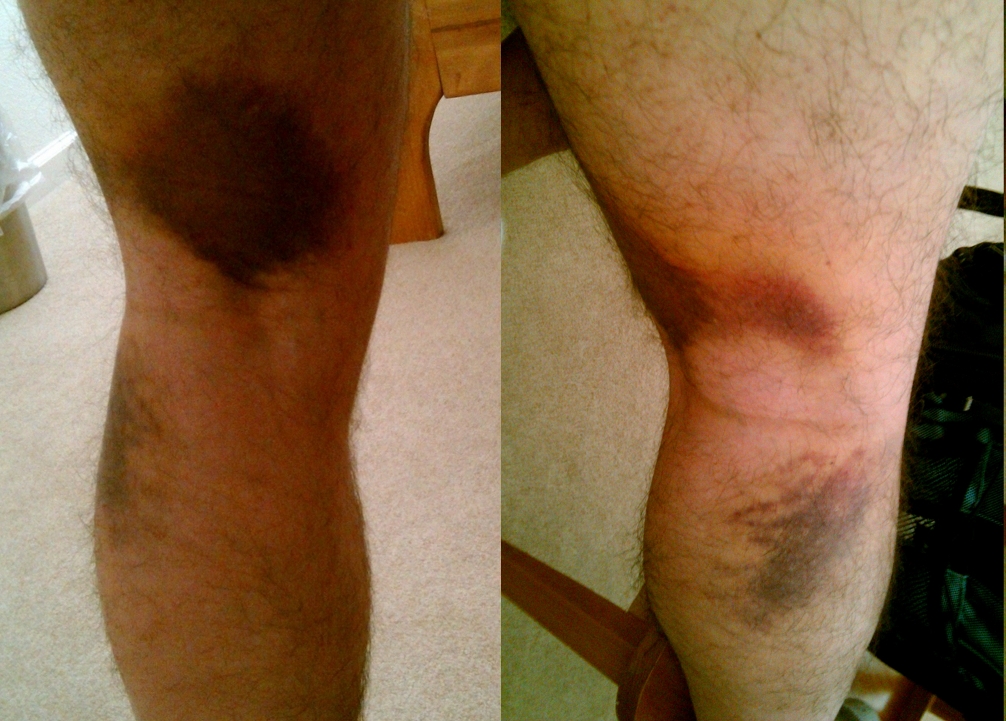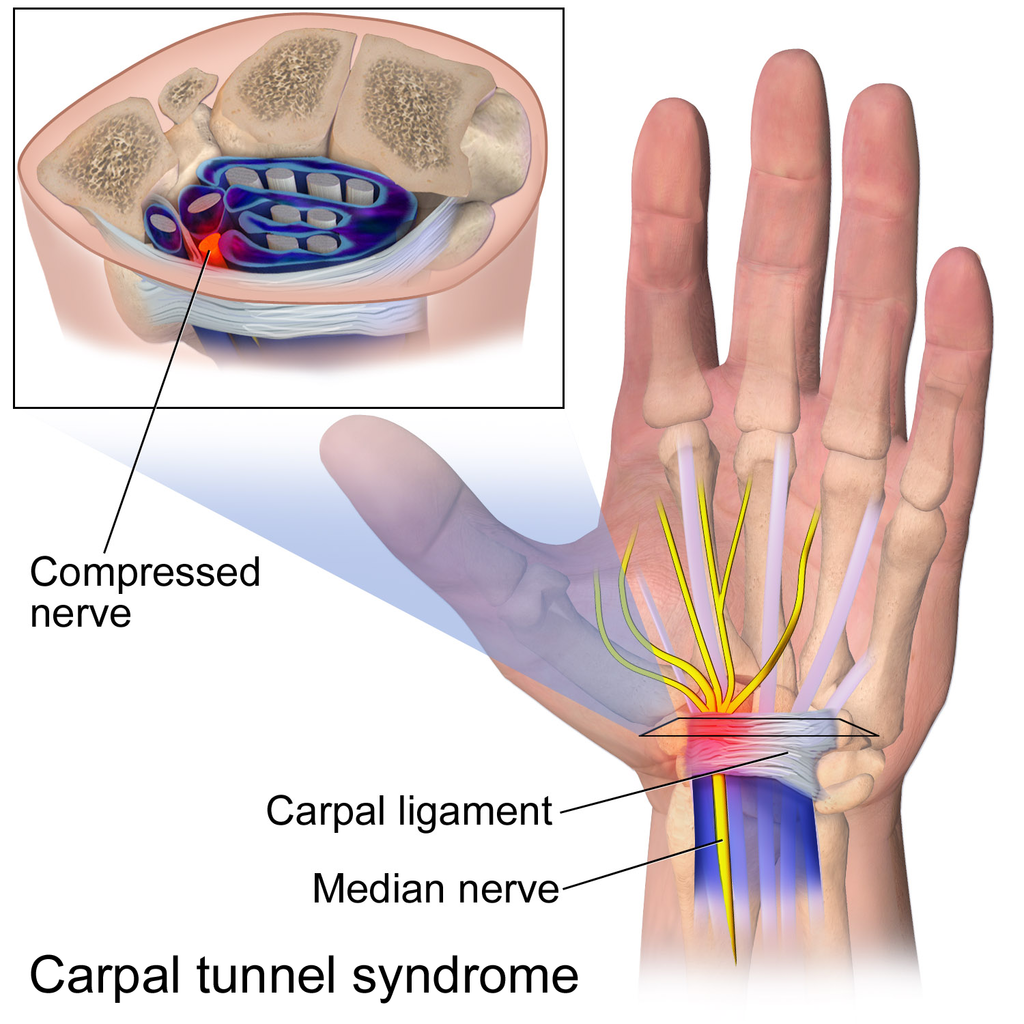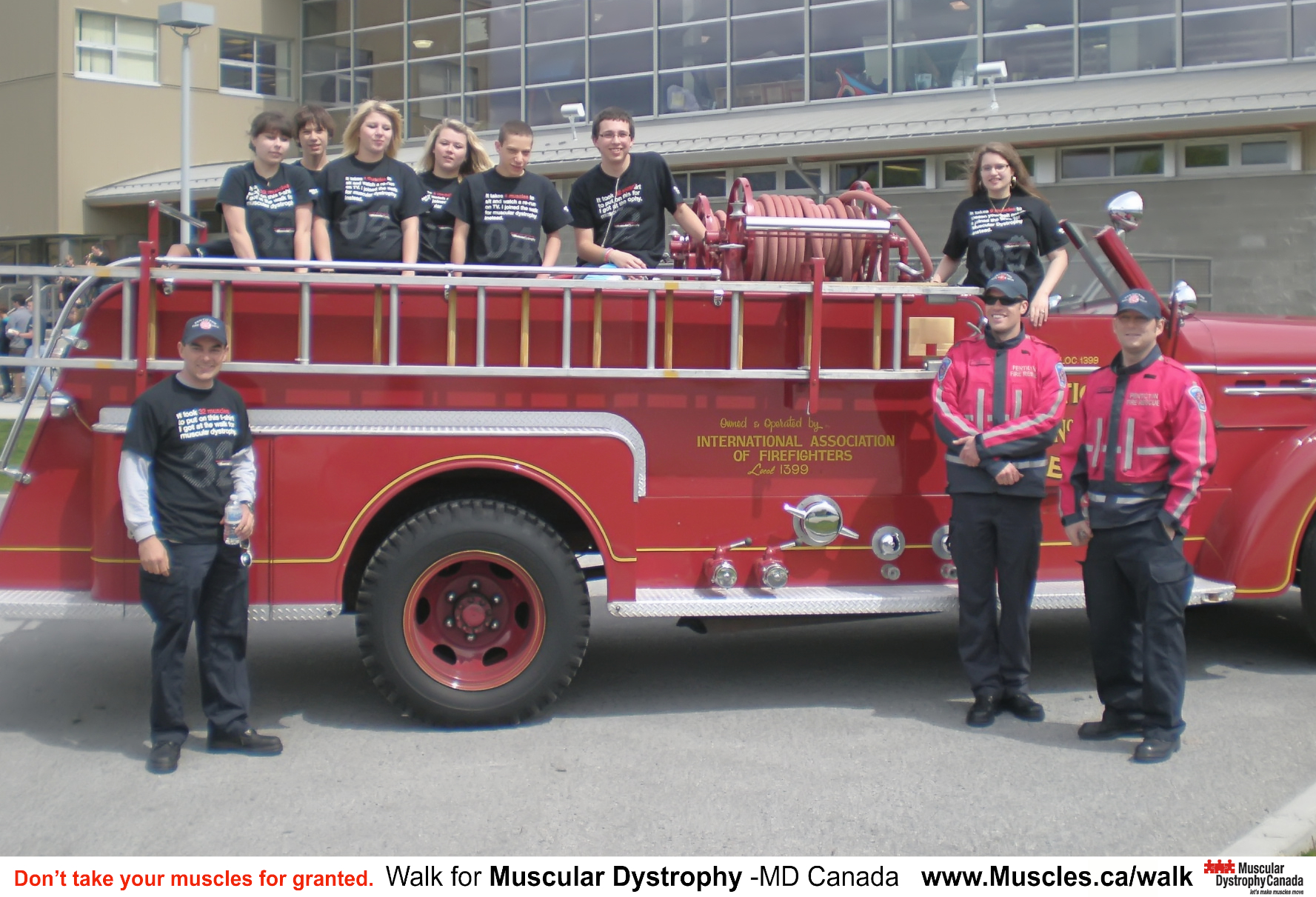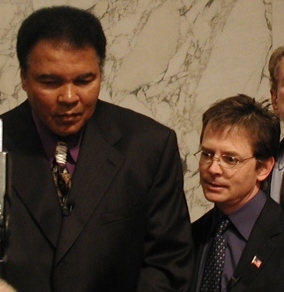114 12.6 Disorders of the Muscular System
Created by CK-12 Foundation/Adapted by Christine Miller

Pain in the Neck
Spending hours each day looking down at hand-held devices is a pain in the neck — literally. The weight of the head bending forward can put a lot of strain on neck muscles, and muscle injuries can be very painful. Neck pain is one of the most common of all complaints that bring people to the doctor’s office. In any given year, about one in five adults will suffer from neck pain. That’s a lot of pains in the neck! Not all of them are due to muscular disorders, but many of them are. Muscular disorders, in turn, generally fall into two general categories: musculoskeletal disorders and neuromuscular disorders.
Musculoskeletal Disorders
Musculoskeletal disorders are injuries that occur in muscles or associated tissues (such as tendons) because of biomechanical stresses. They may be caused by sudden exertion, over-exertion, repetitive motions, or long periods of maintaining awkward positions. Musculoskeletal disorders are often work- or sports-related, and generally just one or a few muscles are affected. They can often be treated successfully, and full recovery can be very likely. The disorders include muscle strains, tendinitis, and carpal tunnel syndrome.
Muscle Strain

A muscle strain is an injury in which muscle fibres tear as a result of overstretching. A muscle strain is also commonly called a pulled muscle or torn muscle. (Strains are often confused with sprains, which are similar injuries to ligaments.) Depending on the degree of injury to muscle fibres, a muscle strain can range from mildly to extremely painful. Besides pain, typical symptoms include stiffness and bruising in the area of the strained muscle. The photo here shows a large bruise caused by a hamstring muscle strain. Hamstring strains are very common in track and field athletes. In sprinters, for example, about one third of injuries are hamstring injuries. Having a previous hamstring injury puts an athlete at increased risk for having another one.
Proper first aid for a muscle strain includes five steps, which are represented by the acronym PRICE. The PRICE steps should be followed for several days after the injury. The five steps are:
- Protection: Apply soft padding to the strained muscle to minimize impact with objects that might cause further damage.
- Rest: Rest the muscle to accelerate healing and reduce the potential for re-injury.
- Ice: Apply ice for 20 minutes at a time every two hours to reduce swelling and pain.
- Compression: Apply a stretchy bandage to the strained muscle to reduce swelling.
- Elevation: Keep the strained muscle elevated to reduce the chance of blood pooling in the muscle.
Non-steroidal anti-inflammatory drugs (NSAIDs, such as ibuprofen) can help reduce inflammation and relieve pain. Because such drugs interfere with blood clotting, however, they should be taken only after bleeding in the muscle has stopped — not immediately after the injury occurs. For severe muscle strains, professional medical care may be needed.
Tendinitis
Tendinitis is inflammation of a tendon that occurs when it is over-extended or worked too hard without rest. Tendons that are commonly affected include those in the ankle, knee, shoulder, and elbow. The affected tendon depends on the type of use that causes the inflammation. Rock climbers tend to develop tendinitis in their fingers, while basketball players are more likely to develop tendinitis in the knees, to name a few examples.
Symptoms of tendinitis may include aching, sharp pain, a burning sensation, or joint stiffness. In some cases, swelling occurs around the inflamed tendon, and the area feels hot and looks red. Treatment includes the PRICE guidelines listed above, as well as the use of NSAIDs to further reduce inflammation and pain. Although symptoms should show improvement within a few days of treatment, full recovery may take several months. A gradual return to exercise or other use of the affected tendon is recommended. Physical or occupational therapy may speed the return to normal activity levels.
Carpal Tunnel Syndrome
Carpal tunnel syndrome is a common biomechanical problem that occurs in the wrist when the median nerve becomes compressed between carpal bones (see Figure 12.6.3). This may occur due to repetitive use of the wrist, a tumor, or trauma to the wrist. Two-thirds of cases are work-related. Computer work, work with vibrating tools, and work that requires a strong grip all increase one’s risk of developing this problem. Carpal tunnel syndrome occurs more often in women than men. Other risk factors include obesity, pregnancy, and arthritis. Genetics may also play a role.

Compression of the median nerve results in inadequate nervous stimulation of the muscles in the thumb and first two fingers of the hand. The main symptoms are pain, numbness, and tingling in these digits. Sometimes, symptoms can be improved by wearing a wrist splint or receiving corticosteroid injections. Surgery to cut the carpal ligament reduces pressure on the median nerve and is generally more effective than nonsurgical treatment. Recurrence of carpal tunnel syndrome after surgery is rare. Without treatment, on the other hand, the lack of nervous stimulation by the median nerve may eventually cause the affected muscles of the hand to weaken and waste away.
Neuromuscular Disorders
Neuromuscular disorders are systemic disorders that occur because of problems with the nervous control of muscle contractions, or with the muscle cells themselves. These disorders are often due to faulty genes and not due to biomechanical stresses. Other system-wide problems, such as abnormal immune system responses, may also be involved in neuromuscular disorders.
Unlike musculoskeletal disorders, neuromuscular disorders generally affect most or all of the muscles in the body. The disorders also tend to be progressive and incurable. However, in most cases, treatment is available to slow the disease progression or to lessen the symptoms. Examples of neuromuscular disorders include muscular dystrophy, myasthenia gravis, and Parkinson’s disease.
Muscular Dystrophy
Muscular dystrophy is a genetic disorder caused by defective proteins in muscle cells. It is characterized by progressive skeletal muscle weakness and death of muscle cells and tissues. Muscles become increasingly unable to contract in response to nervous stimulation. Approximately 50,000 Canadians suffer from muscular dystrophy.
There are at least nine major types of muscular dystrophy caused by different gene mutations. Some of the mutations cause autosomal recessive or autosomal dominant disorders, and some cause X-linked disorders. The most common type of childhood muscular dystrophy is Duchenne muscular dystrophy, which is due to a mutation in a recessive gene on the X chromosome. As an X-linked recessive disorder, Duchenne muscular dystrophy occurs almost exclusively in males.
Different types of muscular dystrophy affect different major muscle groups. In Duchenne muscular dystrophy, the lower limbs are affected. Signs of the disorder usually become apparent when a child starts walking. Difficulty walking becomes progressively worse through childhood. By the time a child is ten, braces may be needed for walking — and walking may no longer even by possible by age 12. The lifespan of someone with muscular dystrophy is likely to be shorter than normal because of the disease, ranging from 15 to 45 years.
In some cases, physical therapy, drug therapy, or orthopedic surgery may improve some of the signs and symptoms of muscular dystrophy. However, at present, there is no known cure for the disorder. Research is ongoing to find a cure, with financial support provided by such sources as Muscular Dystrophy Canada (MDC) (see Figure 12.6.4). MDC is a non-profit organization dedicated to curing muscular dystrophy by funding worldwide research.

Myasthenia Gravis
Myasthenia gravis is a genetic neuromuscular disorder characterized by fluctuating muscle weakness and fatigue. It occurs more commonly in women, and generally begins between the ages of 20 and 40. The initial symptom of myasthenia gravis is painless muscle weakness, generally in muscles around the eye (see photos in Figure 12.6.5). The disease then progresses to muscles elsewhere in the body, eventually involving most of the muscles. Swallowing and chewing may become difficult as the disease progresses, and speech may become slow and slurred. In more advanced cases, myasthenia crises may occur, during which the muscles that control breathing may be affected. Emergency medical care to provide assisted ventilation is required to sustain life. A myasthenia gravis crisis may be triggered by various stressors, such as infection, fever, or stress.

Most commonly, myasthenia gravis is caused by immune system antibodies blocking acetylcholine receptors on muscle cells, as well as the actual loss of acetylcholine receptors. Acetylcholine is the main neurotransmitter used by motor neurons to carry their signals to the muscle fibres they control. With acetylcholine blocked or the receptors lost, muscle cells fail to receive nervous stimulation to contract. Treatment of myasthenia gravis may include medications to counter the effects of the mutant gene or to suppress the immune system.
Parkinson’s Disease
Parkinson’s disease is a degenerative disorder of the central nervous system that mainly affects the muscular system and movement. Four motor signs and symptoms are considered defining in Parkinson’s disease: muscle tremor (shaking), muscle rigidity, slowness of movement, and postural instability. Tremor is the most common and obvious symptom, and it most often occurs in a limb that is at rest, so it disappears during sleep or when the patient moves the limb voluntarily. Difficulty walking eventually develops, and dementia is common in the advanced stages of the disease. Depression is common, as well.
See the video “Neurology – Topic 14 – Parkinsons disease – examining a patient” by UCD Medicine, of a physician examining a patient living with advanced Parkinson’s disease:
Neurology – Topic 14 – Parkinsons disease – examining a patient, UCD Medicine, 2013.
Parkinson’s disease is more common in older people, with most cases being diagnosed after the age of 50. Often, the disease occurs for no known reason. Cases like this are called primary Parkinson’s disease. Sometimes, the disease has a known or suspected cause, such as exposure to toxins in pesticides, or repeated head trauma. In this case, it is called secondary Parkinson’s disease.
Regardless of the cause, the motor symptoms of the disease result from the death of neurons in the midbrain. The cause of cell death is not fully understood, but it appears to involve the buildup in the brain of protein structures called Lewy bodies. Early in the course of the illness, medications can be prescribed to help reduce the motor disturbances. As the disease progresses, however, the medications become ineffective. They also cause a negative side effect of involuntary writhing movements.
Feature: Human Biology in the News
On June 3, 2016, media all over the world exploded with news of the death of Muhammad Ali at the age of 74. The world champion boxer and Olympic gold medalist died that day of complications of a respiratory infection, but the underlying cause was Parkinson’s disease. Ali was diagnosed with Parkinson’s in 1984 when he was only 42 years old. Doctors attributed his disease to repeated head trauma from boxing.
In the days following Ali’s death, the news was full of stories and images from milestones in the athlete’s life, both before and after his diagnosis with Parkinson’s disease. Sadly, the news coverage also provided an overview of his gradual decline as the disease progressed. Ali was pictured in 1996 lighting the flame at the Summer Olympics in Atlanta; however, in 2012, Ali had to be helped to his feet by his wife just to stand before the flag

he was supposed to carry into the stadium. He was unable to carry it because of the ravages of Parkinson’s disease.
Muhammad Ali retired from boxing in 1981 at the age of 39, but he didn’t retire from fighting. Up until the final year of his life, Ali was a passionate activist for peace and justice, and against war and racism. In 1998, he joined Michael J. Fox, who also has Parkinson’s disease, to raise awareness of and funding for research on Parkinson’s disease. In 2002, Fox and Ali made a joint appearance before Congress to present their case (see Figure 12.6.6). In 2005, Ali received the Presidential Medal of Freedom for the many achievements and contributions he made throughout his amazing life, in spite of Parkinson’s disease.
12.6 Summary
- Musculoskeletal disorders are injuries that occur in muscles or associated tissues (such as tendons) because of biomechanical stresses. The disorders may be caused by sudden exertion, over-exertion, repetitive motions, and similar stresses.
- A muscle strain is an injury in which muscle fibres tear as a result of overstretching. First aid for a muscle strain includes the five steps represented by the acronym PRICE (protection, rest, ice, compression, and elevation). Medications for inflammation and pain (such as NSAIDs) may also be used.
- Tendinitis is inflammation of a tendon that occurs when it is over-extended or worked too hard without rest. Tendinitis may also be treated with PRICE and NSAIDs.
- Carpal tunnel syndrome is a biomechanical problem that occurs in the wrist when the median nerve becomes compressed between carpal bones. It may occur with repetitive use, a tumor, or trauma to the wrist. It may cause pain, numbness, and eventually, if untreated, muscle wasting in the thumb and first two fingers of the hand.
- Neuromuscular disorders are systemic disorders that occur because of problems with the nervous control of muscle contractions, or with the muscle cells themselves.
- Muscular dystrophy is a genetic disorder caused by defective proteins in muscle cells. It is characterized by progressive skeletal muscle weakness and death of muscle tissues.
- Myasthenia gravis is a genetic neuromuscular disorder characterized by fluctuating muscle weakness and fatigue. More muscles are affected, and muscles become increasingly weakened as the disorder progresses. Myasthenia gravis most often occurs because immune system antibodies block acetylcholine receptors on muscle cells, and also because acetylcholine receptors are lost.
- Parkinson’s disease is a degenerative disorder of the central nervous system that mainly affects the muscular system and movement. It occurs because of the death of neurons in the midbrain. Characteristic signs of the disorder are muscle tremor, muscle rigidity, slowness of movement, and postural instability. Dementia and depression also often characterize advanced stages of the disease.
12.6 Review Questions
- What are musculoskeletal disorders? What causes them?
- How does a muscle strain occur?
- Define tendinitis. Why does it occur?
- Identify first-aid steps for treating musculoskeletal disorders, such as muscle strains and tendinitis.
- Describe carpal tunnel syndrome and how it may be treated.
- Define neuromuscular disorders.
- Identify the cause and symptoms of muscular dystrophy.
- Outline the cause and progression of myasthenia gravis.
- What is Parkinson’s disease? List four characteristic signs of the disorder.
-
- What are the main differences between musculoskeletal disorders and neuromuscular disorders?
- Why is padding of a strained muscle part of the typical treatment?
- What are two tissues — other than muscle tissue — that can experience problems that result in muscular system disorders?
12.6 Explore More
TEDxAmericanRiviera – Dr. Eric Goodman – The Unexpected Physical Consequences Of Technology, TEDx Talks, 2011.
Deep Brain Stimulation Surgery to treat Parkinson’s Disease at Mount Sinai Hospital,
Mount Sinai Health System, 2013.
Why sitting is bad for you – Murat Dalkilinç, TED-Ed, 2015.
Attributions
Figure 12.6.1
Texting by derick-anies-hDJT_ERrB-w [photo] by Derick Anies on Unsplash is used under the Unsplash License (https://unsplash.com/license).
Figure 12.6.2
pulled_hamstring by Daniel.Cardenas on Wikimedia Commons is used under a CC BY 3.0 (https://creativecommons.org/licenses/by/3.0) license.
Figure 12.6.3
Blausen Carpal_Tunnel_Syndrome by BruceBlaus on Wikimedia Commons is used under a CC BY 3.0 (https://creativecommons.org/licenses/by/3.0) license.
Figure 12.6.4
Firefighters fundraise for muscular dystrophy by Sombilon Studios on Flickr is used under a CC BY-ND 2.0 (https://creativecommons.org/licenses/by-nd/2.0/) license.
Figure 12.6.5
Myasthenia_gravis_ptosis_reversal by Kurukumbi, M., Weir, R.L., Kalyanam, J. et al. on Wikimedia Commons is used under a CC BY 2.0 (https://creativecommons.org/licenses/by/2.0) license.
Figure 12.6.6
Ali and Fox Parkinsons Disease from the Office of Senator Debbie Stabenow is in the public domain (https://en.wikipedia.org/wiki/Public_domain).
References
Blausen.com Staff. (2014). Medical gallery of Blausen Medical 2014. WikiJournal of Medicine 1 (2). DOI:10.15347/wjm/2014.010. ISSN 2002-4436.
Kurukumbi, M., Weir, R.L., Kalyanam, J., Nasim, M., Jayam-Trouth, A. (2008, 25 July). Rare association of thymoma, myasthenia gravis and sarcoidosis : a case report. Journal of Medical Case Reports, 2:245. doi:10.1186/1752-1947-2-245
TED-Ed. (2015, March 5). Why sitting is bad for you – Murat Dalkilinç. YouTube. https://www.youtube.com/watch?v=wUEl8KrMz14&feature=youtu.be
TEDx Talks. (2011, December 3). TEDxAmericanRiviera – Dr. Eric Goodman – The unexpected physical consequences of technology. YouTube. https://www.youtube.com/watch?v=BZcZenvWBlg&feature=youtu.be
UCD Medicine. (2013, January 10). Neurology – Topic 14 – Parkinsons disease – examining a patient. YouTube. https://www.youtube.com/watch?v=sJqKvajUC3k&feature=youtu.be
An injury to muscles or tendons caused by biomechanical stresses.
A disorder that occurs due to problems with the nervous control of muscle contractions or with muscle cells themselves.
Dense fibrous connective tissue that attaches skeletal muscle to bones.
An injury in which muscle fibers tear due to overstretching of a muscle.
Inflammation of a tendon when it is over-extended or worked too hard without rest.
A musculoskeletal disorder that occurs when a nerve becomes compressed between carpal bones in the wrist, leading to reduced innervation of the thumb and first two fingers.
The body system in humans and other animals that protects the organism by distinguishing foreign tissue and neutralizing potentially pathogenic organisms or substances.
A genetic neuromuscular disorder caused by defective proteins in muscle cells and characterized by death of skeletal muscles and progressive weakness.
A gene that can be masked by a dominant gene. In order to have a trait that is expressed by a recessive gene, such as blue eyes, you must get the gene for blue eyes from both of your parents.
Refers to the relationship between two versions of a gene. Individuals receive two versions of each gene, known as alleles, from each parent. If the alleles of a gene are different, one allele will be expressed; it is the dominant gene. The effect of the other allele, called recessive, is masked.
A trait where a gene is located on the X chromosome.
A genetic neuromuscular disorder caused by the immune system blocking or destroying acetylcholine receptors on muscle cells and characterized by progressive muscle weakness and fatigue.
An organic chemical that functions in the brain and body of many types of animals (and humans) as a neurotransmitter—a chemical message released by nerve cells to send signals to other cells, such as neurons, muscle cells and gland cells.
A type of neuron that carries nerve impulses from the central nervous system to muscles and glands; also called efferent neuron.
A long, thin muscle cell that has the ability to contract.
A degenerative brain disorder caused by progressive death of neurons in the midbrain, resulting in muscular symptoms of tremor, rigidity, slowness of movement, and postural instability.
A functional unit of the nervous system that transmits nerve impulses; also called a nerve cell.
Abnormal aggregations of protein that develop inside nerve cells, contributing to Parkinson's disease (PD), the Lewy body dementias (Parkinson's disease dementia and dementia with Lewy bodies), and some other disorders.

